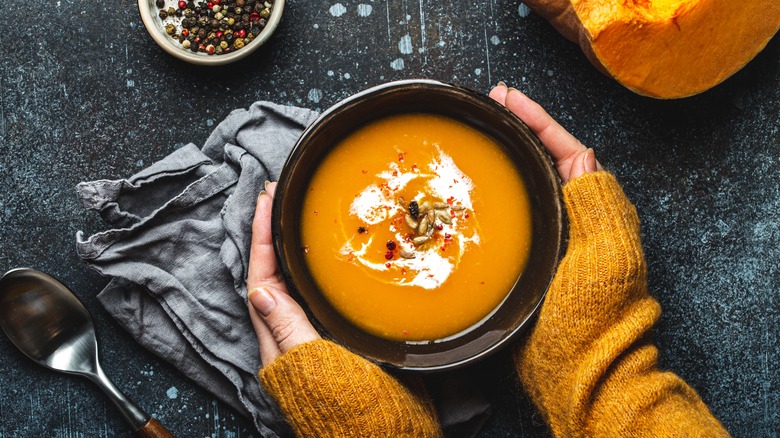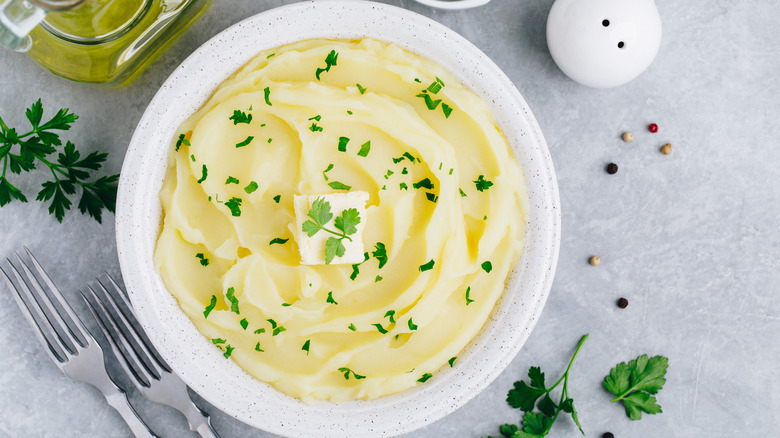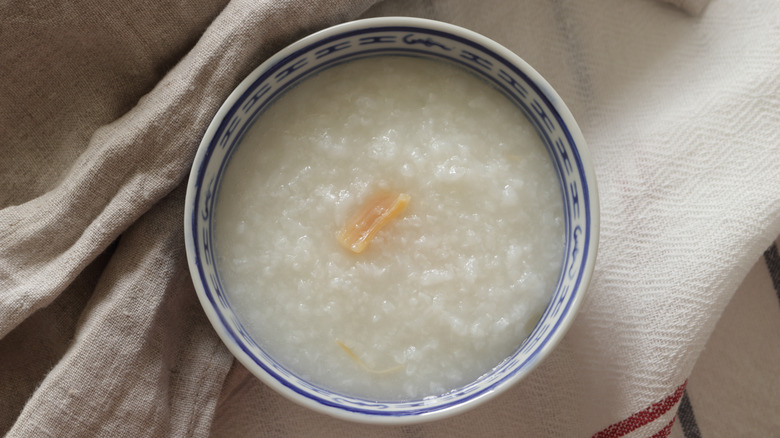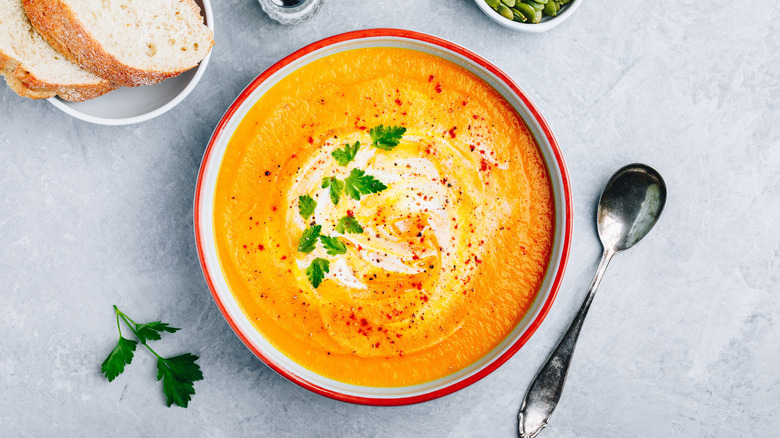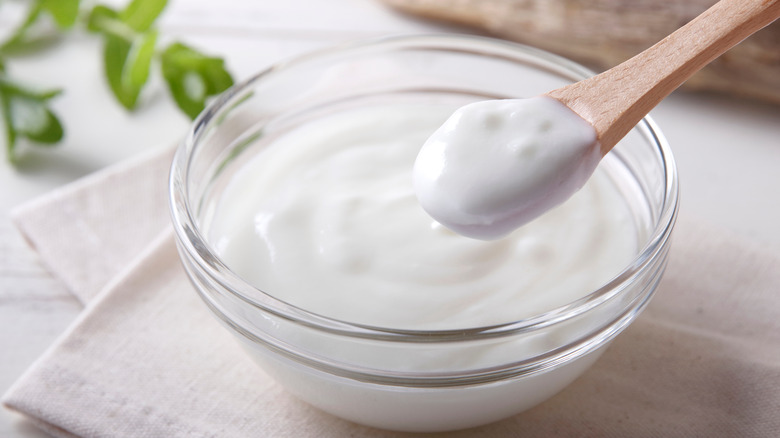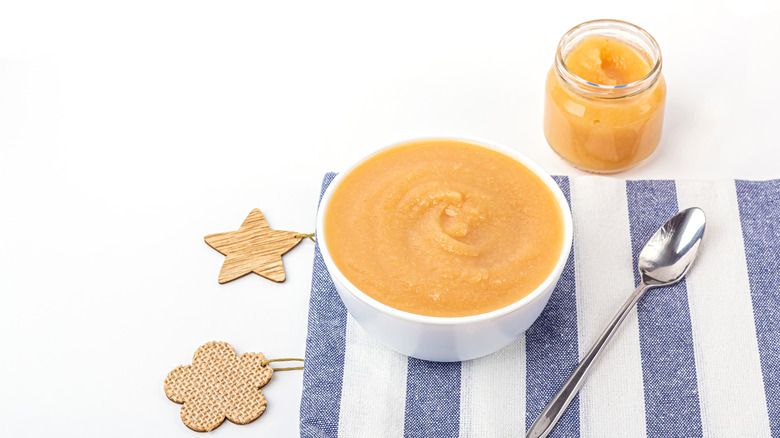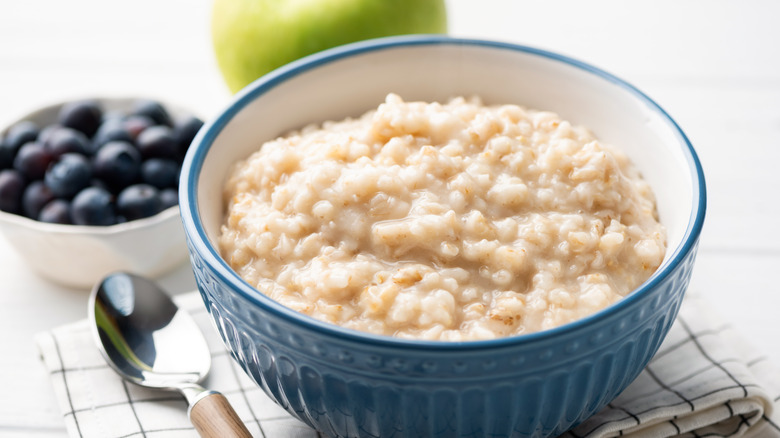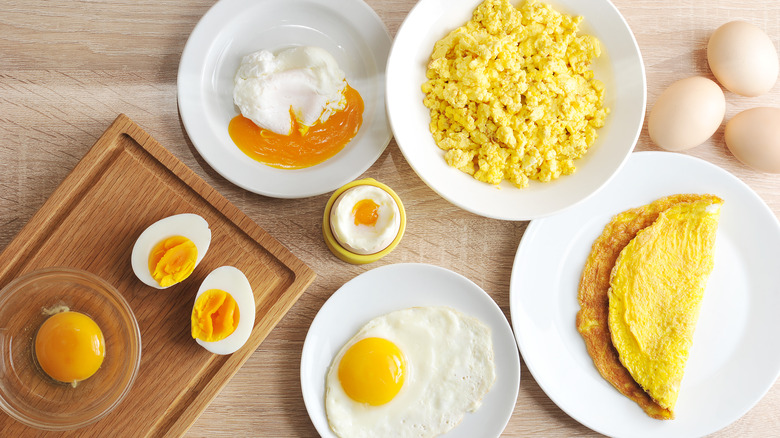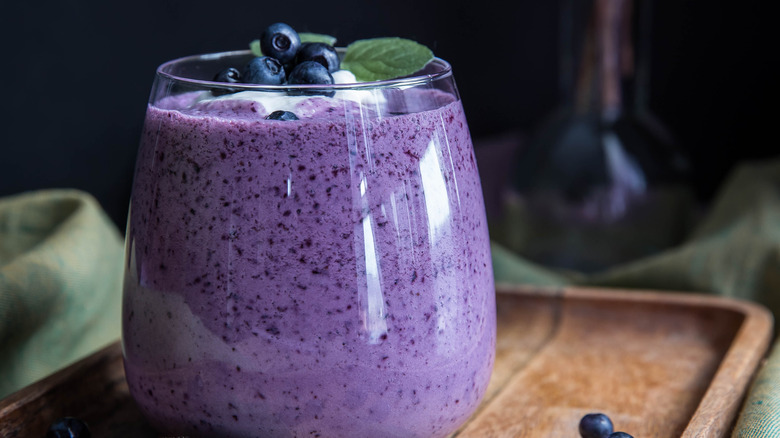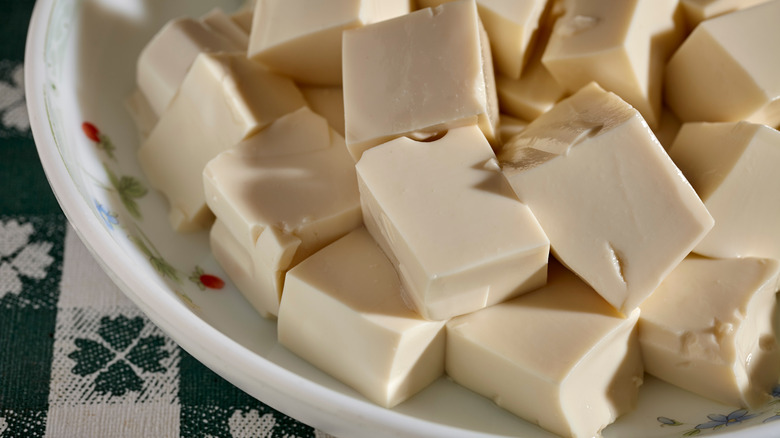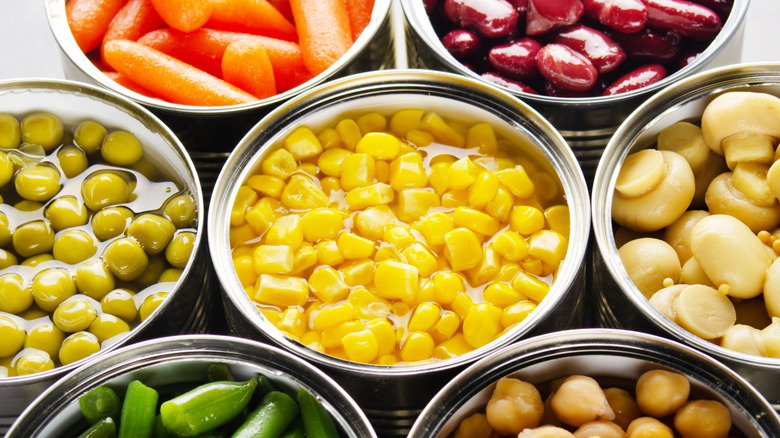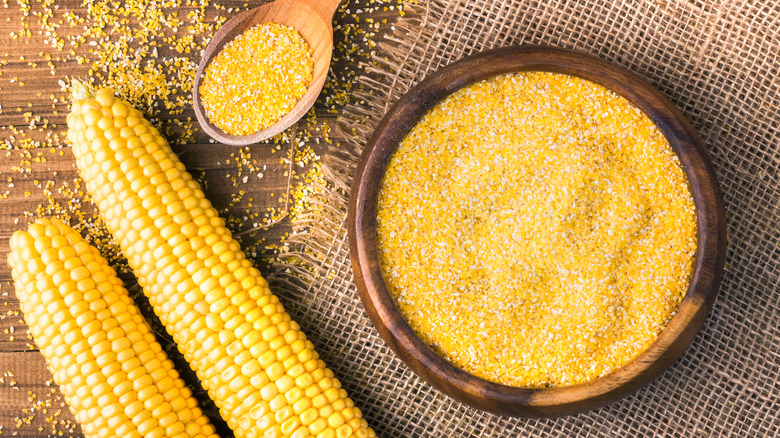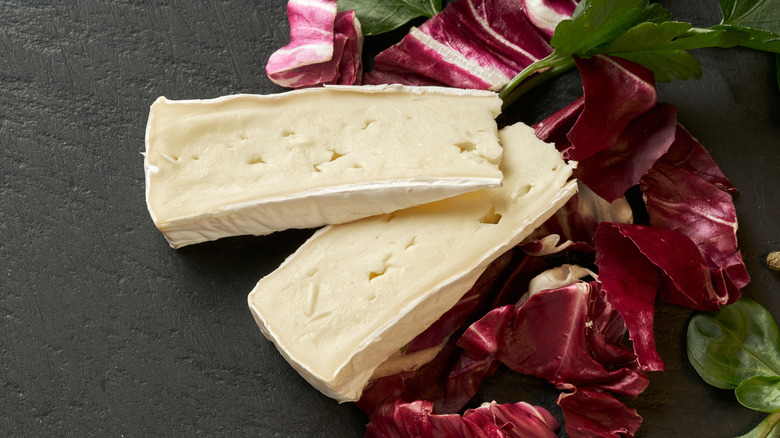13 Satisfying Soft Foods You Have To Try Before You Die
Whether you've just had oral surgery or are having digestive issues, a soft food diet is sometimes necessary to feel your best. But there's one drawback: A lot of times, soft food isn't very appetizing. In fact, WebMD even says that a soft food diet is often called a bland food diet. That's enough to resign yourself to several days or weeks of completely unappetizing, sad foods with barely any flavor and even less texture. But just because you have to eat simply (and softly), it doesn't mean that you can't enjoy what you have on your plate or in your glass.
We've compiled a list of some of the most satisfying soft foods out there. These foods will help you feel your best while taking care of all (or at least most) of your cravings. Take what you love in this list and leave the rest. Just don't be afraid to get creative and try dishes that you haven't encountered before while you're on your soft food journey. Who knows? You may even find some new favorites along the way.
1. Mashed potatoes
When you think of soft food, what's the first thing that comes to mind? If you're a starch lover, you might immediately think of mashed potatoes. They're ultra-soft which means they're always easy to eat. Plus, they pack in a lot of carbs and calories, so it's a good choice when you're on a soft food diet but you're trying to fill up fast. And while plain mashed potatoes straight out of the box may not sound too interesting, mashed potatoes can be glorious when done right.
Take, for instance, Mashed's mascarpone mashed potatoes recipe. The addition of mascarpone cheese adds a creaminess you won't find in other versions, and you can infuse even more flavor with herbs, garlic, broth, or whatever else you have sitting in your cabinets. With a bit of extra work, ordinary mashed potatoes can easily be transformed into the rich flavorful puree of your dreams. Leave a few chunks if you want to add more texture or make it super creamy if you're trying to get the smoothest consistency possible. If there's one soft food staple you should definitely learn how to master, it's mashed potatoes.
2. Congee
Another classic soft food option is congee, which originally hails from China but is now enjoyed all around the world. It's a thick, savory dish made of rice that is stirred continuously while it cooks. The constant stirring results in a creamy texture as the individual grains of rice are broken down. One of congee's best features is the fact that it's a blank canvas — you can add just about anything to make it a complete meal or simply stick with rice and broth for a light snack or something that's easy to get down when you're sick.
Adding some meat like pork or chicken adds a ton of flavor to congee, and if you shred it very thinly it shouldn't be too hard to eat when you're sticking to soft foods. If you want to add in some extra nutrients, try to sneak in veggies that will easily wilt, like seaweed or spinach. Don't forget to add some seasoning either. A spritz of lime or sliced white onion go a long way, as does a soft-boiled egg or some spicy chili oil (if your stomach can handle it). Trust us, once you start eating congee, it will soon become one of your soft food favorites.
3. Pureed soups
Should you be eating a thick stew with huge chunks of meat you have to gnaw your way through when you're on a soft food diet? Of course not, but that doesn't mean you have to give up on soups altogether. In fact, pureed soup is one of the best dishes you can eat when sticking to soft foods. They're usually made with lots of veggies, which can be difficult to get down when you can't bite down on anything crunchy.
So you know you want to make some soup, but what exactly should you make? A classic broccoli cheddar soup is perfect when you're looking for something hearty, and it'll help you incorporate some cruciferous veggies that you may not otherwise be able to eat on a soft food diet. A savory butternut squash soup is also a solid option, though it does require a bit of prep work. Depending on your specific soft food needs, you don't have to stick to pureed soups entirely. Brothy soups that don't have big chunks of meat and veggies can also be a good option to get your fill.
4. Yogurt
Creamy, smooth, sometimes sweet, sometimes acidic — yogurt should be a staple on everyone's shopping list, regardless of whether they're following a soft food diet or not. If you're trying to make it into a whole meal, top your yogurt with soft fruits like bananas or canned mandarins. Use a sweetener like honey or agave (if your yogurt isn't already sweetened) and consider adding any other extras you may enjoy (chia seed pudding, anyone?). However, you'll want to avoid nuts, cacao nibs, and anything else that's too crunchy.
Of course, you don't have to eat your yogurt with sweet add-ins if you prefer a savory profile. Yogurt can serve as a creamy, flavorful addition to all kinds of soft food dishes. In fact, a plop of yogurt right in the middle of a bowl of pureed soup is guaranteed to be delicious. As such a versatile food, having yogurt on hand is always a good idea, and you'll want to be sure to stock up if you're following a soft food diet.
5. Ice cream
When you're focusing on eating soft foods, you may not feel as excited about your meals. However, there's one soft food that's going to be a hit every time — as long as you have a sweet tooth. Ice cream is the perfect dessert when you're looking for soft options to eat and it doesn't require any alterations — it's already a soft food classic.
When it comes to the flavor, don't feel like you have to stick to basic chocolate or vanilla. However, you will want to avoid any ice cream that has large, chunky pieces of candy or nuts in the mix. Moose tracks or pistachio ice cream may be out of the question, for example, but smooth sorbets are fine. If you're on a soft food diet for a limited time and you're feeling gloomy about the foods you're missing out on, you can even go ahead and eat ice cream as a meal. We won't tell.
6. Applesauce
Applesauce is often-overlooked yet it deserves a spot in your diet, especially if you're trying to stick to soft foods. Keep in mind that there are two main types of applesauce to choose from. If you prefer a little more texture, you should look for a chunky variety. That may not sound great when you're trying to avoid hard foods, but usually, even the apple chunks tend to be pretty soft. For those who are really trying to avoid chewing too much, smooth applesauce is the way to go. You get most of the nutrition from apples without having to bite into their tough flesh.
While you can always keep it simple with plain applesauce, we prefer ours with a bit of spice such as cinnamon, which adds an extra delicious dimension. There are so many different applesauce brands out there, so don't be afraid to experiment with something new. And if this isn't a food you're used to eating, give it a try! You may just find that it makes an excellent snack whether you're looking for soft food options or not.
7. Oatmeal
Oatmeal is a soft food classic that you may have in your pantry as we speak. We love this option because it's super healthy and packs plenty of nutrients and fiber into your diet, which can be hard to come by when you're trying to stick to soft foods. And while oatmeal might sound bland and boring, we promise that it can actually be really delicious if you put some effort into making the perfect bowl for yourself.
Want to keep it quick and easy? Start with instant oatmeal. This stuff cooks in no time on the stove or in the microwave, so it's a great option if you are always on the go in the morning. Otherwise, you might want to go for a variety of oatmeal that takes longer to cook, like steel-cut oats.
When you're done cooking the oats, it's time to add toppings. This is where the magic happens, so be sure not to skip this step. Soft fruits like bananas or cooked berries make a great addition, as do sweeteners and other flavorings. Sprinkle in some of your favorite spices or whatever else tastes good to you. And if you want to up the protein factor, you can even add eggs to your oatmeal — yes, you read that right. Trust us, it's actually really good.
8. Eggs
If you're feeling like you're missing out on nutrients while following a soft food diet, it's time to turn to eggs as a solution. In fact, in terms of nutrition, WebMD says that eggs are "hard to beat." While they do contain cholesterol just like all animal products, experts realize that it doesn't affect blood cholesterol as much as foods that are high in saturated fats do. And considering the extra protein eggs offer, it's a good trade-off. They're also relatively low in calories, so you can have a few without worrying about going overboard.
Sure, eggs are delicious for breakfast but don't limit yourself to the morning. Eggs, whether fried, scrambled, poached, or boiled, can be used in so many different ways in just about every meal you whip up. You can even enjoy them on the go as a snack. And since almost all of these cooking methods will leave you with a soft, edible final result, you can truly enjoy your eggs like you would on any other diet.
9. Smoothies
Fruits are notoriously tricky to eat when following a soft food diet. Some options like raspberries or bananas may be fine but many others, like apples and pears, are not. That's not to mention trying to get your daily dose of greens and other veggies. So, what are you supposed to do if you want to make sure you're eating plenty of produce but still adhering to your soft food diet? Enter the smoothie.
Smoothies are amazing in pretty much any capacity, but they can feel like a godsend when you can't eat many solid foods. Plus, the format makes it easy to get plenty of good-for-you vitamins and nutrients you need on a daily basis. The possibilities are endless and whether you want to go for a simple fresh fruit smoothie recipe or prefer something a little more out of the ordinary, there's a smoothie out there for you. Have a few recipes on hand, and you can throw an easy meal together in minutes. Easy, tasty, and soft food-diet friendly? Sign us up!
10. Silken tofu
If you're new to the world of tofu, you may not be so sure about this one. But we assure you, silken tofu is a solid soft food choice and it can be used in so many different ways. Like all types of tofu, silken tofu is high in protein, which means it offers the nutrition you need to get through your day. It's delicious when eaten raw with a sauce over top and it makes a fresh, fun lunch that's healthy and soft food-friendly. It's also an excellent addition to smoothies, contributing to their creaminess thanks to the rich, soft texture.
But perhaps our favorite use of silken tofu is in the Korean dish called sundubu jjigae. It's a spicy stew that often features other sources of protein like shrimp or ground meat. While it may sound complicated to make, it's something you can easily whip up in your own kitchen as long as you follow a recipe the first time. This stuff is perfect for winter, especially when it's served with an egg. Try this dish, and you'll never feel sad about being on a soft food diet again.
11. Canned vegetables
So, you need to get your veggies in but the thought of biting into a crunchy stalk of celery makes you want to cry? We get it. Unfortunately, a lot of fresh produce has a crispness to it that's just not ideal when you're on a soft food diet. But that doesn't mean you have to give up your veggie habit completely. One option is to start eating canned vegetables instead. While Insider says that canned products packed in brine or loaded with sodium can be bad for you, most of the time, veggies stored in water are a healthy choice.
And the best part? Canned vegetables tend to be softer than their fresh counterparts. Because they have been sitting in liquid for some time, they don't hold on to that same snap you'll find in fresh veggies. This makes canned vegetables like green beans and carrots excellent choices for when you're on a soft food diet. Sure, they may not taste as good as the real thing, but if you doctor them up with garlic, onions, and some spices, you'll probably find that they taste better than you ever could have imagined.
12. Grits
We talked about congee and oatmeal. Now, it's time for grits to make an appearance. If you grew up in the Southern U.S., you know what all the hype is about. Think of grits as the corn equivalent of oatmeal. Cooked well, grits have a pleasantly creamy texture and they can be paired with pretty much anything you have in your kitchen (eggs, for example). Some people prefer their grits sweetened and sprinkle in sugar, while others like savory grits with butter and salt. Whichever direction you want to take it, there's a good chance you're going to enjoy this Southern classic.
While you may be tempted to eat shrimp with your grits, that isn't necessarily ideal if you're following a soft food diet — especially if you're working with large shrimp. Luckily, cheese, small pieces of meat, soft vegetables, and even fruit can be added to cooked grits to add more flavor and substance.
13. Soft cheese
Need a little treat after eating so much soft food? If there's one thing that'll brighten your day, it's soft cheese. Here at Mashed, we love all cheeses and we don't want to discriminate. But we have to admit that there's something about soft cheeses that feels so much more luxurious and celebratory than their harder cousins. Trying to pick cheese in this category is easy — there are so many different options to choose from.
Brie is an obvious pick, as its creamy texture turns to silk when it's heated even slightly and it tastes delicious paired with jam or lemon curd. Burrata can easily be added to a salad to switch up the texture, while Camembert is ideal if you're looking for a Brie alternative that stinks in just the right way. Feta and ricotta can be sprinkled over other dishes, and both mascarpone and cream cheese immediately enhance the texture with a rich creaminess. The possibilities are endless.
